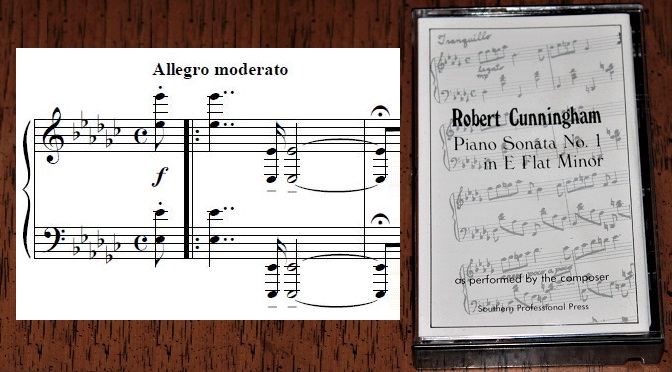The Story of Piano Sonata No. 1
My Piano Sonata No. 1 was completed in February 1982. This four-movement sonata was the first composition that I deemed worthy of sharing with the public, and the following year my own recording of the sonata was released by Southern Professional Press in cassette format. The soundtrack from that 1983 recording, along with images from a Finale score which I transcribed in 2021 from the original handwritten manuscript, is used in videos on my RobertCunninghamsMusic channel for each of the four movements and for the sonata as a whole. (These videos can be viewed at the end of this post.)
The cassette’s eloquent liner notes were written by the late William R. Scarborough, and they provide intriguing insights into the historical context and genesis of this composition. I am therefore reproducing them in full below.
| The past two decades have been the fertile ground from which has blossomed a new efflorescence of romanticism in music. Rebounding from the stifling academic obsession with an emotionally sterile modernism, new interest in romanticism has flourished, from the popularization of Mahler in the early 1960s to John Williams’s film music of the past few years. One of the finest new fruits of this renascence is the Piano Sonata No. 1 in E Flat Minor by Robert E. Cunningham, Jr. composed during 1981-1982. This work stands firmly in the late romantic tradition exemplified by such masters as Tchaikovsky, Rachmaninoff, MacDowell and Taneyev, redolent of chromaticism yet solidly tonal, expressive of well-seasoned emotions and soundly crafted.
The first movement (Allegro moderato, in E flat minor, 4/4 time) is in strict sonata-allegro form, adhering to a classical key scheme. There is a repeat of the exposition. The head motif, with its repeated chords and rising octave passage, will become a unifying element among the contrasting moods explored in the work: an idée fixe as frequently heard in the romantic period. The second theme has a brooding quality, rising to a climax. The emotional potentials of both themes are explored in the development, which ranges from angry to somber. Recapitulation and a brief coda follow. The ending of the first movement, recalling the head motif, provides a bridge to the Scherzo (also in E flat minor, 2/4 time), which begins by repeating the last two chords. The staccato main theme of the Scherzo is twice interrupted by a trio section: in a contrasting Spanish/Moorish flavor, it first appears in duple, later in triple meter. The third movement, marked Tranquillo (4/4, in D flat major), uses three themes. The opening theme, a peaceful, lyrical promenade, has a distinctly Chopinesque flavor. It is followed by an equally lyrical but more striving theme. The ardent third theme could easily be described as a “love” theme, bearing a family resemblance to Romeo’s theme from Tchaikovsky’s Romeo and Juliet. A misterioso section is notable, as is the peaceful conclusion using parallel fifths. The final Allegro, in the unusual meter of 7/4, is the sonata’s most contrapuntal movement, introducing and developing two well-contrasted themes. The first theme consists largely of a rather agitated, frequently staccato triplet figure, originating in E flat minor; the second is a dignified, chorale-like theme. Both themes are put through their paces separately in canon and fugato. After a climactic pause, the coda begins with both themes in counterpoint, a joyous duet in E flat major. The sonata ends with the repeated chords of the opening movement’s head motif. Mr. Cunningham was born in 1948. He attended Duke University and Juilliard, majoring in piano. He currently resides in Atlanta, Ga., and is employed as a computer programmer/analyst. Mr. Cunningham has several more compositions at or near completion, including a setting of Shakespeare’s Sonnet #18 (“Shall I compare thee to a summer’s day?”) for baritone, alto recorder, and piano, and a Romance for Clarinet and Piano. William R. Scarborough |
Piano Sonata No. 1 (complete):
I. Allegro moderato:
II. Scherzo:
III. Tranquillo:
IV. Finale:






